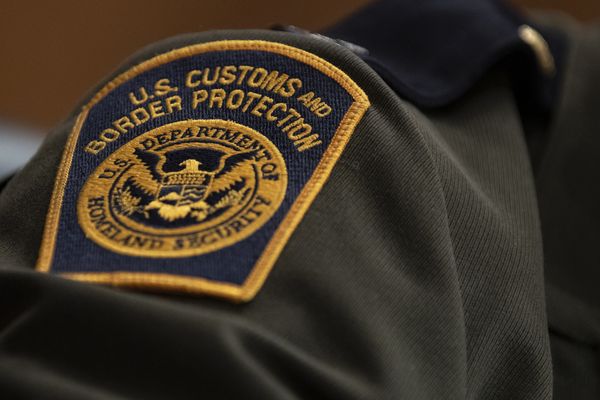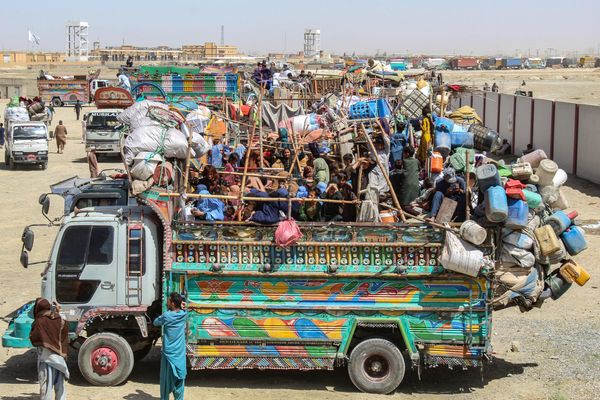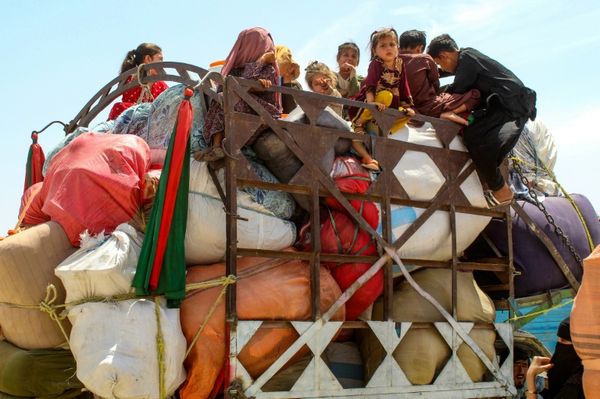
Tamika Tilbrooke emerges from a diner by the side of the Bruce Highway beneath a pair of sodden and forlorn mango trees, holding a litre of Coca-Cola and two plastic cups. One is for her husband, Bobby, still working hard on their Bluewater home, a few kilometres up the creek that gives this outer suburb north of Townsville its name.
Tamika bought the cups and the soft drink because the house no longer has running water or kitchenware fit for use. And the young couple are thirsty. They’ve spent the day wading through the muck and detritus inside that home, their first, which they proudly bought together two years ago and in which – until a few days ago – they were happily raising their two children: Mia, 12, and seven-year-old Jaxson.
“Everything, everything is gone,” Tamika says.
It is a drizzly Tuesday afternoon. Over the weekend, however, the rain fell in a steady deluge, swelling Bluewater creek, which borders the Tilbrooke property, into a torrent that broke its banks.
The family watched chicken coops, sheds, freezers and a trailer, sweep across their 1.2 hectare (3-acre) block. Then, suddenly, the Bluewater – now a dirty brown – was at their back porch.
“Grab the kids and the dog,” Tamika says, explaining what went through her mind in that moment on a Sunday she is unlikely to ever forget.
“It was terrifying. It was really scary. It was so fast. I’ve never seen the water rise that fast before. Ever.”
As the water raged through the Tilbrooke bungalow and the family sought refuge at a friend’s property on higher ground, their phones pinged with an evacuation warning.
“The house had been completely under for at least an hour when we got that message,” Tamika says.
When the flood water subsided and the road to Townsville was passable again, the Tilbrookes packed the one bag they had managed to grab in the mad rush to leave. In it, some clothes. Medication. Jaxson’s stuffed rabbit. Then they drove to Tamika’s parents’ place in the suburb of Kirwan.
“It’s crazy to go to the shops and get all the mundane things,” she says. “Jocks and socks and bras and, you know, just the normal things that you take for granted.
“We’ve got none of that now.”
Those who survive natural disaster are often quick to declare themselves lucky – others had it worse, they say. The Tilbrookes are no exception. They have family to lean on. They are insured.
But everyone mucking in one room with two kids on a blow-up mattress is no long-term solution. And their insurer has already warned the Tilbrookes: don’t expect to be going home anytime soon.
It is not just a matter of the massive cleanup to come next; not just throwing things out, replacing them and doing the paperwork. The house will have to be rewired, sanitised and, much of it, rebuilt. Materials and tradies will be in short supply.
Bobby is already preparing himself to make a call he hoped he would never have to make again. Even as he squelches through a kitchen in which drawers are still full of flood water, dodging coconuts, stepping over a log and through a slurry of sticks and treasures – lace from his wife’s wedding dress, his mother’s funeral program – he laughs at a memory: the moment he handed the keys of his last rental back to the real estate agent through whom he had been a long-term tenant.
“I said: ‘Thanks mate, I hope to never have to see you again, and I mean that in the most loveliest way’,” Bobby recalls.
“He said: ‘100% mate, it’s great to break free of the rental market’.
“And we’re at the point now where I’ll be giving him a call this week saying: ‘Have you got anything for us?’”
Despite their insurance, the couple are under no illusions about the “battle” to which they are about to reengage. “There is a rental crisis in Townsville,” Tamika says. “So that makes things tricky”.
And yet, in some ways, the Tilbrookes are right. They are more fortunate than a significant number of others who call the north home. Towns like Ingham have been cut off for days, fuel, water and food supplies dwindling. There, two women died in flood waters.
Some of the Tilbrookes’ neighbours were also hit in 2019, when they were displaced for longer than 12 months after Townsville experienced what was said to be its worst flooding event in 120 years.
Data from the Australian Competition and Consumer Commission suggests approximately one in five north Queenslanders, or more than 62,000 properties, are uninsured because people cannot afford to do so.
The flow-on effect from unaffordable and rising premiums is a looming reaction from the banking sector, which could ultimately cause “tanking” home values in entire suburbs and towns. Flooding is “Australia’s most costly natural peril”, according to the Insurance Council of Australia, with about 1.2m properties facing some flood risk.
The ICA says the number of people restoring inundated homes without the backing of an insurer is growing. There is a widening gap between “those who can afford insurance and those who can’t, particularly in areas most vulnerable to extreme weather risk”.
Some of north Queensland’s 62,000 or so uninsured homes are in Bluewater, and their owners – already setting off on the daunting road to recovery ahead of them – did not want to talk to press.
Time is of the essence. Mould has already sprouted in the Tilbrooke shed. Once the humidity kicks in, Bobby says, “it’ll be floor to roof”.
Even those fortunate enough to have an insurance policy are not guaranteed a payout. When the Bluewater burst its banks in 1998 and 1.5 metres of water flowed through the home of Elisabet and Philip Hutchinson, their insurer at the time asked for documentation.
“Our paperwork is out there in the Coral Sea,” Philip told them.
The Hutchinsons did not receive a payout. Yet they stayed; they refinanced their mortgage, raised their house by more than 2 metres – and changed their insurer.
Twenty-seven years and several floods later, the Hutchinsons are still in Bluewater. They didn’t leave, even over the weekend, as others fled. Their son has grown and flown the coop so, this time, they chose to stay put.
“This is my haven,” Elisabet says. “The other times, I used to be at my parent’s or my sister’s and, you know, the stress, oh my gosh – what’s going on?”
Others might have felt more stressed watching the water rise, quite literally, below their feet, counting the steps it climbed towards their doors and windows, marooned upon the island of their home. Elisabet says it helped her process it all.
Their sanctuary held, but the Hutchinsons, too, have a big clean up ahead.
“In 2019 we had six fridge freezers in our yard,” Philip says. “None of them ours,” Elisabet adds.
Back in 2019, Guardian Australia spoke with people in Townsville and insurers about the situation after the “once in a lifetime flood” that affected homes in the north Queensland city.
Almost six years to the day later, those same suburbs were labelled a “black zone” in Townsville from which hundreds of people were forced to flee as flood waters inundated streets.
In the words of the premier, David Crisafulli, Townsville “dodged a bullet”.
Dr Karl Mallon, the CEO of Climate Valuation and an expert in climate risk, says the situation is “Groundhog day, but worse” because insurers have increasingly incorporated flood mapping and data into their risk assessments in recent years. “You can’t shop around because all the insurers are on to it”, he says.
Properties in flood zones are offered high premiums that reflect the risk and some insurers won’t cover them at all. “Most of the people in high-risk flood zones would not have flood cover, because they can’t afford it,” Mallon says.
The sense of deja vu serves to highlight that little has been done in the meantime to put communities in a better position this time around. The speed with which policymakers and others are moving to address community resilience does not seem to be keeping pace with the increasing frequency of extreme weather events.
Old hands at this caper, the Hutchinsons are among the first to begin piling ruined and relocated objects upon the footpath. Soon small pyramids of junk will dot the suburb.
“You aren’t missing a wheelie bin, are you?” Elisabet cheerfully asks a passersby.
Sometimes, though, insurance just doesn’t seem worth the hassle. On the other side of the Bruce highway, on the road to Toolakea beach, Mitch O’Loghlin is putting the finishing touches on a long stretch of temporary fence he banged out in a day after his own washed away.
“It’s not worth us accessing our insurance to fix fences,” the concreter says. “I can fix fences meself.”
He will do a more permanent job of it when he finds the time – for now, the dog needs a space to run.
O’Loghlin was in the Northern Territory for work on the weekend and couldn’t get home to help prepare for the flood; his partner and two young children had to flee their new home. The water here flows fast – it was mere centimetres from entering their house.
He and his family have only recently moved north. This near miss, however, has not daunted his enthusiasm for northern life.
All the locals swear by Bluewater under blue skies. There are no crocodiles here, they say, whatever the signs say. Most residents swim in the paperbark-lined creek every day. There are barramundi to be caught – but, shhh, don’t let the secret out. It’s paradise, they say … when not in flood.
“We were looking at shoeboxes in Brisbane to buy,” O’Loghlin says. “The price after Covid just went stupid. We come up here, [we saw] this place, and that was it.
“It’s sorta what you sacrifice to come out and live out here like this. I wouldn’t swap it”.
Many of these little patches of paradise were built over the course of the last three decades. At the time little was known, or was publicly available, about flood peaks.
So when Darryl Brown built in Bluewater in 1996, he made an educated guess about the height of the stilts upon which he would put his new house. Water went through two years later and again in 2019. He and wife, Ann, lived in a caravan for 12 months while the house was repaired.
On Sunday the property flooded, but the house stayed dry. Every flood is different, they say, the topography having changed as new houses and roads are built. This time, Darryl’s guess proved good – for now, at least.
“That’s my dove orchid,” Ann says anxiously, pointing at a plant in her lush garden. “And that means rain.”
Those flowers may prove a portent of things to come. On Friday, the Bureau of Meteorology forecast up to 80mm for Bluewater, up to 130mm the next day and 70mm the following.
Across the north, people are peering at the skies in apprehension and prayer. Ann looks at her little white flowers.
“Hopefully, it’s just a delayed reaction.”







